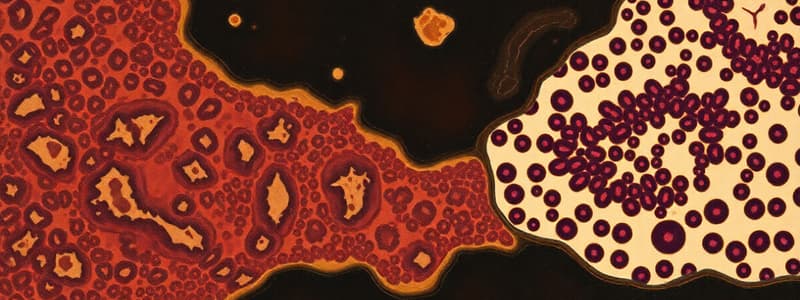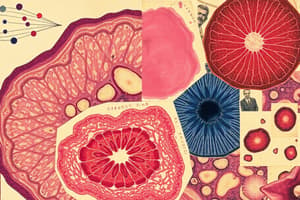Podcast
Questions and Answers
What is the scientific study of tissues called?
What is the scientific study of tissues called?
- Physiology
- Histology (correct)
- Anatomy
- Cytology
Epithelial tissue is specialized for exchange with the environment.
Epithelial tissue is specialized for exchange with the environment.
True (A)
What are the four types of tissues in the human body?
What are the four types of tissues in the human body?
Epithelial, Connective, Muscular, Nervous
Connective tissue protects and _______ supports _______ the body.
Connective tissue protects and _______ supports _______ the body.
What type of muscle tissue is characterized by branched, striated fibers with a single nucleus?
What type of muscle tissue is characterized by branched, striated fibers with a single nucleus?
Match the following types of cell junctions with their descriptions:
Match the following types of cell junctions with their descriptions:
Which type of tissue generates body heat through contraction?
Which type of tissue generates body heat through contraction?
Skeletal muscle tissue is under involuntary control.
Skeletal muscle tissue is under involuntary control.
Desmosomes connect adjacent cells and have no role in resisting contraction.
Desmosomes connect adjacent cells and have no role in resisting contraction.
What is the primary function of smooth muscle tissue?
What is the primary function of smooth muscle tissue?
Nervous tissue generates _______ electrical _______ signals called nerve impulses.
Nervous tissue generates _______ electrical _______ signals called nerve impulses.
The cells in cardiac muscle tissue are connected by _____ for rapid electrical signal conduction.
The cells in cardiac muscle tissue are connected by _____ for rapid electrical signal conduction.
Match the following types of cells with their functions:
Match the following types of cells with their functions:
What type of secretion occurs in merocrine glands?
What type of secretion occurs in merocrine glands?
Sebaceous glands are classified as holocrine glands.
Sebaceous glands are classified as holocrine glands.
What is the main function of collagen fibers in connective tissues?
What is the main function of collagen fibers in connective tissues?
In apocrine glands, products are secreted only from the _______ face of cells.
In apocrine glands, products are secreted only from the _______ face of cells.
Match each type of connective tissue to its description:
Match each type of connective tissue to its description:
Which type of fiber provides elasticity to connective tissues?
Which type of fiber provides elasticity to connective tissues?
Epithelial tissue is typically vascularized.
Epithelial tissue is typically vascularized.
What do macrophages do in connective tissues?
What do macrophages do in connective tissues?
The ________ matrix is the material found between the cells and fibers in connective tissue.
The ________ matrix is the material found between the cells and fibers in connective tissue.
What type of connective tissue is characterized by tightly woven reticular fibers?
What type of connective tissue is characterized by tightly woven reticular fibers?
What type of connective tissue primarily provides strong support and is found in tendons and ligaments?
What type of connective tissue primarily provides strong support and is found in tendons and ligaments?
Elastic connective tissue contains primarily collagen fibers.
Elastic connective tissue contains primarily collagen fibers.
What is the main function of mucous membranes?
What is the main function of mucous membranes?
Hyaline cartilage provides a smooth surface between bones at __________.
Hyaline cartilage provides a smooth surface between bones at __________.
What layer is found deep to the epidermis in cutaneous membranes?
What layer is found deep to the epidermis in cutaneous membranes?
Match the type of cartilage with its description:
Match the type of cartilage with its description:
Bone tissue includes a liquid extracellular matrix called plasma.
Bone tissue includes a liquid extracellular matrix called plasma.
Which cells in bone tissue are responsible for maintaining bone matrix?
Which cells in bone tissue are responsible for maintaining bone matrix?
The __________ lines and lubricates joints and contains only connective tissue.
The __________ lines and lubricates joints and contains only connective tissue.
Which of the following best describes the composition of lymph?
Which of the following best describes the composition of lymph?
What is the primary function of the basement membrane?
What is the primary function of the basement membrane?
All epithelial cells have an apical surface which faces underlying tissues.
All epithelial cells have an apical surface which faces underlying tissues.
What are the two layers of the basement membrane called?
What are the two layers of the basement membrane called?
The structure of epithelial tissues can be described by the number of layers and the shape of the cells, such as __________ and __________.
The structure of epithelial tissues can be described by the number of layers and the shape of the cells, such as __________ and __________.
Match the type of epithelial tissue with its primary function:
Match the type of epithelial tissue with its primary function:
Which type of epithelial tissue is specialized for secretion and absorption in kidney tubules?
Which type of epithelial tissue is specialized for secretion and absorption in kidney tubules?
Exocrine glands secrete their products directly into the bloodstream.
Exocrine glands secrete their products directly into the bloodstream.
How do cilia function in ciliated epithelial tissues?
How do cilia function in ciliated epithelial tissues?
Glandular epithelium can be classified into __________ and __________ glands.
Glandular epithelium can be classified into __________ and __________ glands.
Match the function of the gland to its type:
Match the function of the gland to its type:
Flashcards are hidden until you start studying
Study Notes
General Overview of Tissues
- Tissues consist of groups of cells derived from a common progenitor that work together to perform specific functions.
- Four primary types of human tissues: epithelial, connective, muscular, and nervous.
- The scientific study of tissues is known as histology.
Epithelial Tissue Functions
- Covers and protects body surfaces as well as lines hollow organs.
- Forms glands for secretion of enzymes, hormones, and other fluids.
- Specialized for exchange processes with the internal and external environments.
Connective Tissue Functions
- Protects and supports the body and internal organs, connecting them together.
- Stores energy and aids in immune response.
Muscular Tissue Functions
- Composed of specialized cells that contract to generate force.
- Assists in body heat production.
Nervous Tissue Functions
- Detects external and internal stimuli.
- Generates electrical signals (nerve impulses) that regulate muscle and gland activity.
Cell Junctions
- Cell junctions are connections between adjacent cells critical for communication.
- Five main types: tight junctions, adherens junctions, desmosomes, hemidesmosomes, and gap junctions.
Types of Cell Junctions
- Tight Junctions: Create leakproof seals between cells, important in the stomach lining and intestinal epithelium.
- Adherens Junctions: Connect adjacent cells, utilizing transmembrane and cytoplasmic proteins to strengthen tissue against forces.
- Desmosomes: Reinforce connections between cells against stretching, crucial for skin and heart muscle stability.
- Hemidesmosomes: Anchor cells to the underlying basement membrane, preventing abrasion.
- Gap Junctions: Allow for direct chemical and electrical communication between neighboring cells through connexons.
Epithelial Tissue Structure
- Described by two main features: the number of cell layers (simple, stratified, pseudo-stratified) and cell shape (squamous, cuboidal, columnar, transitional).
- Epithelial cells are polar, featuring apical (inner), basal (underlying tissues), and lateral (adjacent cells) surfaces.
Types of Epithelial Tissue
- Simple Squamous: Specialized for filtration and diffusion (e.g., endothelium, mesothelium).
- Simple Cuboidal: Involved in secretion and absorption (e.g., kidney tubules, thyroid gland).
- Simple Columnar: Functions in secretion and absorption; can be ciliated for mucus movement (e.g., gastrointestinal tract).
- Stratified Squamous: Provides protection against abrasion; may be keratinized or non-keratinized.
- Stratified Cuboidal & Columnar: Rare types found lining certain ducts and glands.
- Transitional Epithelium: Changes shape based on stretching, found in the bladder and ureters.
Glandular Epithelium
- Glands can be exocrine (secreting onto surfaces) or endocrine (releasing hormones into the bloodstream).
- Mixed glands, such as the pancreas, have both exocrine and endocrine functions.
Types of Exocrine Glands
- Merocrine Glands: Secrete via exocytosis, including sweat glands.
- Apocrine Glands: Release products from the apical surface, such as mammary glands.
- Holocrine Glands: Secrete by rupturing cells, exemplified by sebaceous glands.
Connective Tissue Overview
- Composed of extracellular matrix (ECM) and cells, less cellular than epithelial tissue.
- Types include loose connective, dense connective, cartilage, bone, and liquid connective tissues.
- Cells primarily include fibroblasts, macrophages, plasma cells, mast cells, and adipocytes.
Extracellular Matrix (ECM)
- Comprised of proteins and ground substances; provides structural and functional support.
- Contains three fiber types: collagen (increases tensile strength), elastic (provides elasticity), and reticular (supports tissue structure).
Types of Mature Connective Tissues
- Loose Connective Tissue: Includes areolar and adipose tissue; supports organs and stores energy.
- Dense Connective Tissue: Includes regular (tendons, ligaments) and irregular (skin) connective tissues, providing strength in varying directions.
- Cartilage: Strong yet flexible tissue; includes hyaline, fibrocartilage, and elastic types, each with specific functions.
Bone Tissue
- Comprised of compact or spongy structures; contains osteons for organization.
Liquid Connective Tissues
- Blood: Contains plasma and blood cells; essential for transporting nutrients, gases, and waste.
- Lymph: Composed of varying components, predominantly lymphocytes.
Anatomical Membranes
- Composed of epithelial and connective tissue types, including mucous, serous, cutaneous, and synovial membranes with distinct functions in protecting and lubricating body organs.
Muscular & Nervous Tissues
- Muscular tissue enables movement and generates heat; types include skeletal, cardiac, and smooth.
- Nervous tissue contains excitable cells involved in signal transduction and coordination of body functions.### Skeletal Muscle Tissue
- Long, multinucleate cells with striations that enable voluntary movement.
- Responsible for maintaining posture and generating body heat.
- Connects to bones using tendons.
Cardiac Muscle Tissue
- Composed of branched, striated fibers with a single nucleus per cell.
- Cells interconnected by gap junctions to facilitate rapid electrical signal conduction.
- Functions under involuntary control.
- Forms the myocardium, which is the heart wall.
Smooth Muscle Tissue
- Features long, non-striated fibers composed of irregularly-shaped cells with a single nucleus.
- Cells have a thickened middle section and are connected by gap junctions.
- Facilitates involuntary muscle contractions such as peristalsis and constriction of airways.
- Involved in the contractions of the urinary bladder and gallbladder.
Nervous Tissue
- Composed of two primary cell types:
- Neurons:
- Contain a cell body, dendrites, and an axon.
- Generate electrical signals or nerve impulses.
- Neuroglia:
- Do not produce electrical impulses.
- Synthesize myelin, a protective coating for axons that enhances the speed of electrical signal transmission.
- Neurons:
Studying That Suits You
Use AI to generate personalized quizzes and flashcards to suit your learning preferences.




